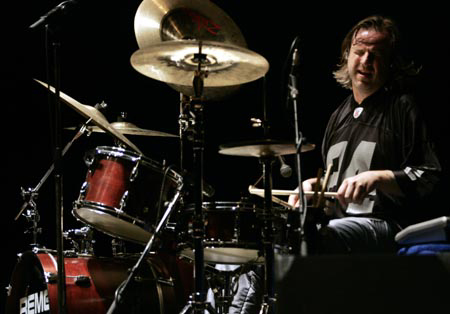R = Right L = Left B =
Bass drum
This first example is a classic Gadd lick which is
great as a rhythmic embellishment. It is derived from this
pattern, itself a re-voicing of a straight sixteenths groove 'RLRL' on
the hi hat.

The groove is then altered with the use of the double
stroke roll off the beat and a couple of substitutions where the bass
drum sounds.

VIDEO
 AUDIO
AUDIO

This second example is a classic Gadd groove and can
be heard on 'Leprichauns dream' by Chick Corea. It was a great
departure at the time from 'normal' drum grooves and involver the use of
the open playing stance where the hands do not cross onto the hi hat.
The basis of this linear pattern is the use of the inverted paradiddle
between the small tom, snare and hi hat.

VIDEO
 AUDIO
AUDIO

Honestly, a triplet sticking pattern that I can't get
enough of. RLL is the first unit (A) and RRL is the second unit
(B). Combinations of A and B can lead to some easily executable
rapid fire patterns around the kit.
VIDEO
 AUDIO
AUDIO
 (Bounce triplet 1)
(Bounce triplet 1)
VIDEO
 AUDIO
AUDIO
 (Bounce
triplet 2)
(Bounce
triplet 2)
VIDEO
 AUDIO
AUDIO

Just by accenting all the right strokes, and then all
the left strokes of the paradiddle, you can end up with a really
effective fill.

VIDEO
 AUDIO
AUDIO

Or, if you play it with the right hand on the hi hat
and the left hand on the snare also accenting the back beat, you get the
basis of an interesting groove basis. This really works when you
start to add bass drum independence to it.

VIDEO
 AUDIO
AUDIO

If we extend the concept of the paradiddle into the
'long symmetrical sticking' then we can certainly get to some
interesting concepts. This example involves a whole double
paradiddle (RLRLRRLRLRLL) followed by the first half of the paradiddle (RLRR).
Then this leads us onto the opposite hand for the second bar which
becomes the opposite of the first bar. It makes the entire
symmetrical unit two bars long. See my book 'Symmetrical stickings for
the snare drum' available on H&H publishing in the UK.

VIDEO
 AUDIO
AUDIO


